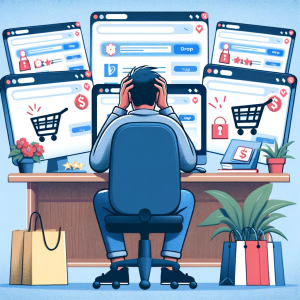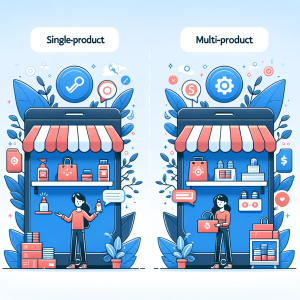
In 2024, with many customers experiencing dropshipping fatigue (a phenomenon driven by an influx of sellers employing questionable practices), establishing dropshipping credibility is necessary to attract new customers.
In this article, I'll be covering the following topics:
Click here to start selling online now with Zendrop
Before we begin, it’s highly recommended that beginners focus on one niche for their brand so as not to overcomplicate their first foray into dropshipping. This will also make creating a professional-looking dropshipping store much easier.
Between single-product stores and multi-product stores, neither model is inherently better than the other. However, a multi-product store comes with many benefits that beginners would find very attractive. In many cases, Multi-product store lends more credibility to your brand. To stay ahead in the competitive ecommerce landscape, it's essential to understand dropshipping strategies that resonate with customers and foster trust.
Let's examine the pros and cons of each model to better grasp how they fit into the current market scenario.
| Pros | Cons |
|
|
|
|
|
|
|
|
|
|
|
The rise of multi-product stores in the dropshipping domain is a strategic response to combat the prevalent issue of avoiding dropshipping scams.
| Pros | Cons |
|
|
|
|
|
|
|
|
|
|
|
|
|
At first glance, the single-product store seems like a great place to start for beginners. Don’t get me wrong, many expert dropshippers find massive success with single-product stores. However, they come with their own set of challenges.
Let's explore these often-overlooked pitfalls that could hinder the growth of new entrants into dropshipping.

Many beginners will likely spend much of their time looking for viable products and testing potential winners. With enough time and experience, you’ll begin to develop a sense for what makes a winning product, allowing you to save time and money.
Read more on How to Find The Best Dropshipping Products In 2024
But until then, you’ll face various challenges when looking for winning products. Single-product stores are practically one-and-done type deals, whether for better or for worse. Imagine the following scenario:
You’ve just discovered a product that you think will do really well. You design a logo, create a brand name, build a store, register all the social media profiles for your product, and order a sample for you to inspect in real life. That’s at least three weeks of your time. Not to mention the financial costs of registering a domain, getting a Shopify account, and logo and brand design.
You finally decided to test the product. So you start filming TikTok content, designing graphical creatives, and making all the assets you need to run ads on Meta and TikTok. You could easily spend over $200 during this phase.
From here, you have two outcomes: either the product flops or it succeeds. In the case that it fails, you have to find a new product. That means creating a new store, designing a new logo, coming up with a new brand name, registering a new domain, coming up with new social accounts, ordering a new sample, and more. That’s new subscription fees, a new Meta Pixel, and a new Meta Business account.
And if the product succeeds, what then? You scale the product as much as you can before you inevitably hit a wall. At which point, you realize that to grow, you either have to add new products to the store, or start a new one. Or what if your product becomes saturated, what then? Do you have to abandon your store?
Single-product stores carry many long-term disadvantages that beginners just aren’t equipped to deal with.
On the other side of the spectrum, multi-product stores offer a different set of advantages and challenges. Here’s why beginners might find them more advantageous in the long run.

On the flip side, Multi-product stores are not as complicated as many beginners might think. The biggest misconception is that a multi-product store will require much more work to get started than a single-product store. To an extent, this is true. After all, more products means more descriptions and pages.
However, it’s not really THAT much more work. You can always copy and paste existing product pages, and with the advent of AI tools like Jasper.ai or ChatGPT, you can generate first drafts for product descriptions.
In many ways, a multi-product store has all the pros of a single-product store and very few of the cons. Let’s go back to the hypothetical scenario in Example 1. With a multi-product store, pretty much all of those obstacles become easy to address. Let’s say your product fails, forcing you to look for a new one.
Unlike with the single-product store, you DON’T have to create a new store, design a new logo, come up with a new brand name, register a new domain, come up with new social accounts, pay for new Shopify subscription fees, get a new Meta Pixel, and have Facebook approve a new Meta Business account. You can skip all the tedious logistical tasks and get right to testing your new product. On top of that, you can still leave your old product on the store to capture residual sales.
Essentially, you’re using your multi-product store like you’re testing a single-product store! On top of that, you get the added benefit of having multiple items on your catalog, showcasing your store as a professional brand. In the case your product gets too saturated, you don’t have to abandon your store and existing audience. You can announce your new product to your existing customers, giving you free advertising and a boost to sales.
As dropshipping for beginners becomes more popular, it's critical to address the dropshipping fatigue issue by creating a customer-centric shopping experience. Before concluding, let's consider some essential tips for both aspiring and seasoned dropshippers. These insights will help you make informed decisions, whether you opt for a single-product or a multi-product store.
Regardless of what sort of store you decide to start, remember that success comes with effort and research. Just remember the following:
As we wrap up, it's clear that the path to dropshipping success is nuanced and requires a thoughtful approach. Whether you choose a single-product or a multi-product store, the key lies in consistent effort, thorough research, and an understanding of current market dynamics. Ecommerce customer trust is the new currency in the digital age, and multi-product stores offer a blueprint for building that trust effectively.
By embracing flexibility, staying attuned to customer perceptions, and continuously adapting your strategies, you can overcome dropshipping fatigue and build a credible, thriving business. Remember, in the world of ecommerce, authenticity and quality always stand out.
Make sure to check out How to Find The Best Dropshipping Products In 2024 so you can find dropshipping success in 2024.
